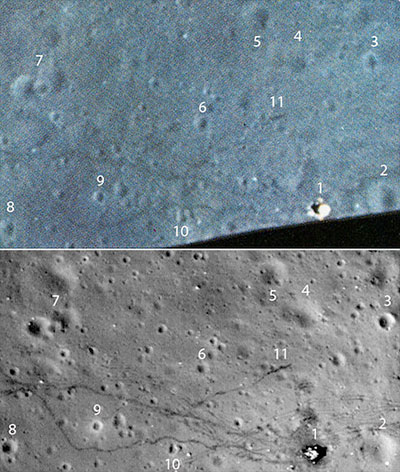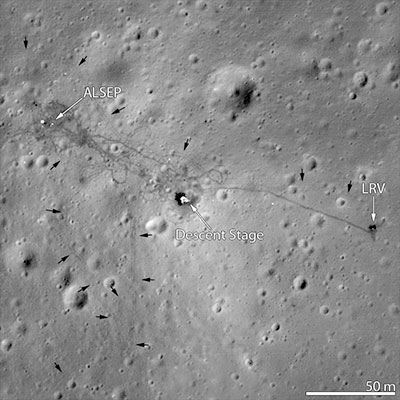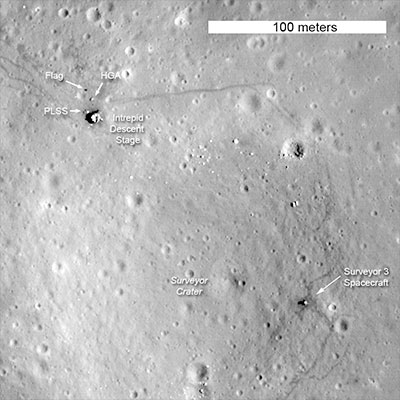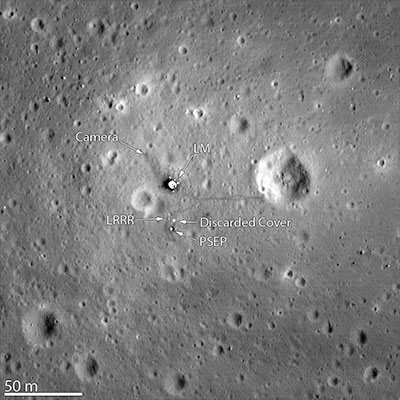|
Author
|
Topic: [Discuss] Lunar Reconnaissance Orbiter
|
Jeff
Member Posts: 587
From: Fayetteville, NC, USA
Registered: May 2009
|
 posted 11-07-2009 06:33 AM
posted 11-07-2009 06:33 AM
   
After I enlarged the image, I noticed two dark spots or shadows to the front right (direction of flight) of the descent stage. That's to say, Quad 4 between the +Z and +Y footpads... a little way out from the LM. Could these shadows possible be the S-Band antenna that was eventually blown over during the crews "hot fire" of the RCS prior to ascent, and the flag? Does anyone else see that, or am I just imagining it? |
mmmoo
Member Posts: 577
From: London, England
Registered: May 2001
|
 posted 11-07-2009 06:48 AM
posted 11-07-2009 06:48 AM
   
On this Apollo 12 panorama you can see two dark depressions in the surface, could that be the two dark spots?Also visible on the QTVR Movie. |
Jeff
Member Posts: 587
From: Fayetteville, NC, USA
Registered: May 2009
|
 posted 11-07-2009 07:22 AM
posted 11-07-2009 07:22 AM
   
That's a good point, but I'm not really convinced, only because the new image was taken with the sun very high over head, which has a tendency to wash out any surface shadows made from depressions. Case in point, when I look at the first image that is labeled and shows Surveyor 3, the "Belly of the Snowman" is not visible to me, and that's a pretty large depression. That's why I think it's something that is standing "above" the surface, not depressed in it, and the two shadows are in the "historically correct" location of the S-Band and flag. |
Jeff
Member Posts: 587
From: Fayetteville, NC, USA
Registered: May 2009
|
 posted 11-07-2009 08:09 AM
posted 11-07-2009 08:09 AM
   
quote:
Originally posted by FFrench:
Can we tell from the shadow in this low-pixel (at high zoom) image whether the flag has survived at all...
That's partly what I'm asking in relation to the Apollo 12 image. As you stated, it's been predicted that the flags that we left would have long ago turned black and disintegrated. But, if that's the case why would there be a shadow that stands out so prominently on the Apollo 17 image? The flag pole was what? Three or four centimeters in diameter? I find it hard to believe that the pole with yardarm alone would cast such a visible shadow. |
Rick Boos
Member Posts: 851
From: Celina, Ohio
Registered: Feb 2000
|
 posted 11-07-2009 11:59 AM
posted 11-07-2009 11:59 AM
   
Jeff, good point! I was thinking the same thing! |
Jurg Bolli
Member Posts: 1185
From: Albuquerque, NM
Registered: Nov 2000
|
 posted 03-25-2010 03:01 PM
posted 03-25-2010 03:01 PM
   
Cool crater, thanks for posting this image (and the others). |
Rick Boos
Member Posts: 851
From: Celina, Ohio
Registered: Feb 2000
|
 posted 03-25-2010 07:28 PM
posted 03-25-2010 07:28 PM
   
Great photos! Has NASA ever said why there hasn't been any good views of Apollo 15's landing site? Keep seeing all the other sites. |
hlbjr
Member Posts: 551
From: Delray Beach Florida USA
Registered: Mar 2006
|
 posted 03-31-2010 06:56 AM
posted 03-31-2010 06:56 AM
   
What was the velocity at impact for 13's SIVB? I wonder if there would be any identifiable debris in the bottom of the impact crater? |
mikej
Member Posts: 483
From: Germantown, WI USA
Registered: Jan 2004
|
 posted 03-31-2010 08:17 AM
posted 03-31-2010 08:17 AM
   
According to the Saturn V Launch Vehicle Flight Evaluation Report: AS-508 Apollo 13 Mission, the impact velocity was 2579 m/s (8461 ft/s), which works out to about 5769 mph. |
SpaceAholic
Member Posts: 5245
From: Sierra Vista, Arizona
Registered: Nov 1999
|
 posted 05-25-2010 11:19 AM
posted 05-25-2010 11:19 AM
   
Galaxy Zoo has leveraged the LRO images to stand up its MOONZOO site: As announced by Galaxy Zoo: It's been nearly 40 years seen Apollo astronaut Eugene Cernan became the last man to walk on the lunar surface, but at moonzoo.org/live you can take your own journey over lunar surface.The site is powered by the efforts of visitors to Moon Zoo - the latest project from the team that brought you Galaxy Zoo and Solar Stormwatch. Using the site, you'll see images from NASA's Lunar Reconnaissance Orbiter which show the lunar surface in unprecedented detail, and with a few clicks you can record what you find while exploring. |
LM-12
Member Posts: 3780
From: Ontario, Canada
Registered: Oct 2010
|
 posted 02-05-2011 12:23 PM
posted 02-05-2011 12:23 PM
  
The LROC Browse Gallery has just posted a great photo of the Apollo 14 landing site and Cone Crater. Most of the EVA tracks can clearly be seen. It's a nice way to mark the 40th anniversary of the moonwalk. |
Space Cadet Carl
Member Posts: 305
From: Lake Orion, MI
Registered: Feb 2006
|
 posted 08-11-2011 08:58 AM
posted 08-11-2011 08:58 AM
   
It's just been announced that LRO will temporarily dip down to a 20KM (12.4 mile) orbit from August 14th to August 19th, 2011. This is specifically being done in an attempt to image the Apollo landing sites at four times better resolution than previously received from LRO. NASA says it's going to be a technical challenge to successfully return good images because LRO will still be streaking past the Apollo landing sites at 3,500 MPH, making it difficult to prevent blurring in the images. This is a really exciting attempt, so wish the LRO team good luck and let's see what happens! |
bunnkwio
Member Posts: 114
From: Naperville, IL USA
Registered: Jul 2008
|
 posted 08-20-2011 01:31 PM
posted 08-20-2011 01:31 PM
   
After the amazing pictures sent back of the Apollo landing sites, has the LRO taken any pictures of the impact sites of the Saturn IV-B stages? I am curious to know what the resulting impact crater, or possible pieces of debris, would look like. |
Robert Pearlman
Editor Posts: 50476
From: Houston, TX
Registered: Nov 1999
|
 posted 08-20-2011 01:34 PM
posted 08-20-2011 01:34 PM
   
In March 2010, LRO imaged the Apollo 13 S-IVB impact site. In October 2009, LRO imaged the same for Apollo 14. |
Space Cadet Carl
Member Posts: 305
From: Lake Orion, MI
Registered: Feb 2006
|
 posted 08-30-2011 10:26 AM
posted 08-30-2011 10:26 AM
   
It's been two weeks since LRO dipped down into a 12.4 mile orbit, attempting to obtain higher resolution Apollo landing site images. Does anyone know if the attempt was successful? |
Robert Pearlman
Editor Posts: 50476
From: Houston, TX
Registered: Nov 1999
|
 posted 09-01-2011 03:18 PM
posted 09-01-2011 03:18 PM
   
NASA release NASA Announces Media Teleconference on New Apollo ImagesNASA will host a media teleconference at noon on Tuesday, Sept. 6, to reveal new images of three Apollo landing sites taken from the agency's Lunar Reconnaissance Orbiter, or LRO. Teleconference participants are: - Jim Green, director, Planetary Science Division, NASA Headquarters, Washington
- Mark Robinson, principal investigator, Lunar Reconnaissance Orbiter Camera, Arizona State University, Tempe
- Richard Vondrak, LRO project scientist, NASA's Goddard Space Flight Center, Greenbelt, Md.
Supporting information and visuals for the briefing will be posted at 11:45 a.m. EDT Sept. 6. |
Space Cadet Carl
Member Posts: 305
From: Lake Orion, MI
Registered: Feb 2006
|
 posted 09-02-2011 10:08 AM
posted 09-02-2011 10:08 AM
   
Keep your fingers crossed because this was a tough challenge for the team. We may have some very cool images to look at next week. |
Blackarrow
Member Posts: 3602
From: Belfast, United Kingdom
Registered: Feb 2002
|
 posted 09-02-2011 01:07 PM
posted 09-02-2011 01:07 PM
  
I don't suppose anyone knows which 3 sites were imaged? Could this be inferred from the orbit? |
Robert Pearlman
Editor Posts: 50476
From: Houston, TX
Registered: Nov 1999
|
 posted 09-06-2011 11:29 AM
posted 09-06-2011 11:29 AM
   
The new sharper views are from Apollo 12, 14 and 17. |
Rick Boos
Member Posts: 851
From: Celina, Ohio
Registered: Feb 2000
|
 posted 09-06-2011 08:38 PM
posted 09-06-2011 08:38 PM
   
quote:
Originally posted by Rick Boos:
Has NASA ever said why there hasn't been any good views of Apollo 15's landing site? Keep seeing all the other sites.
I am wondering if it has anything to do with the location... would love to know why after this long period of time? |
Robert Pearlman
Editor Posts: 50476
From: Houston, TX
Registered: Nov 1999
|
 posted 09-06-2011 08:49 PM
posted 09-06-2011 08:49 PM
   
Richard Vondrak, Lunar Reconnaissance Orbiter project scientist, said today that it primarily has to do with illumination at the site at the time the spacecraft passes within view. Given the way the narrow angle camera is aimed, all of the Apollo sites are imaged at an oblique angle, requiring the sun angle to be complimentary for details to be discerned.With regards to this low orbit pass, Vondrak commented, "we only spent one month in this very low altitude orbit and because the ground track of the spacecraft crosses the moon not always over each of the Apollo landing sites — since the six landing sites were distributed across the face of the moon — it wasn't possible to image easily all six sites. Some of the illumination conditions were not optimal, for the Apollo 11 site in particular." With that said, here is the Apollo 15 landing site as viewed by LRO from its nominal orbit. |
Rick Boos
Member Posts: 851
From: Celina, Ohio
Registered: Feb 2000
|
 posted 09-06-2011 09:58 PM
posted 09-06-2011 09:58 PM
   
Thanks! I thought it might have had something to do with location and lighting conditions. Maybe in time we might still get some great views. |
dabolton
Member Posts: 419
From: Seneca, IL, US
Registered: Jan 2009
|
 posted 09-07-2011 04:35 PM
posted 09-07-2011 04:35 PM
  
How come the LRO images of the Apollo landers aren't much clearer? Is it difficult with the lighting on the moon to obtain high resolution quality photos? This comes from the notion that the government can read license plates from space. |
Blackarrow
Member Posts: 3602
From: Belfast, United Kingdom
Registered: Feb 2002
|
 posted 09-07-2011 08:38 PM
posted 09-07-2011 08:38 PM
  
If U.S. spy satellites can "read licence plates from space" the technology will not be made available to NASA until it is obsolete. As I recall, the Apollo panoramic camera (used on Apollos 15-17) was a declassified former "spy camera" with 2-metre resolution at orbital height (which could show the LM as a white dot casting a shadow). If NASA ever sends a camera to the Moon which can resolve the individual rungs on a lunar module ladder from lunar orbit, rest assured the spy satellites in Earth orbit will be able to resolve the screws mounting the license plates to their cars. |
Paul Littler
Member Posts: 70
From: Brentwood, Essex, UK
Registered: Jul 2003
|
 posted 09-09-2011 06:55 AM
posted 09-09-2011 06:55 AM
   
If I recall the main reason for LRO having a really close look at the Apollo landing sites was because NASA had obviously already been able to survey them in greater detail than the rest of the moon. The LRO mission would therefore, by having the Apollo sites as a comparison, stand more chance of finding a new crater at an Apollo site than in other areas of the Moon.So is there any news of new craters formed since the 1970s? And what does this say about the chances of a future long term base on the Moon suffering a meteorite strike? |
Robert Pearlman
Editor Posts: 50476
From: Houston, TX
Registered: Nov 1999
|
 posted 09-09-2011 12:08 PM
posted 09-09-2011 12:08 PM
   
At the suggestion of a contributor, Phil Plait has created a side-by-side comparison of a frame from the 16mm camera on Apollo 17's lunar module looking down at the Apollo 17 landing site and LRO's latest image of the same. I had a weird sense of being there, a feeling that was visceral instead of intellectual. Sure, I know we've been to the Moon, multiple times. But these pictures really — pardon the odd metaphor — bring it home. And when you think that what we're seeing from LRO in its lonely orbit around the Moon is the same as what the astronauts saw by simply looking out their window... well.It's pretty amazing what we can do sometimes, isn't it?  |
Paul78zephyr
Member Posts: 797
From: Hudson, MA
Registered: Jul 2005
|
 posted 09-13-2011 01:29 PM
posted 09-13-2011 01:29 PM
  
These are quite remarkable photographs however to me they still seem a bit fuzzy considering the low orbit (31 miles) and lack of any atmospheric interference. They seem less clear then when I look at Google satellite images of my own street where I can clearly make out my own car. If it wasn't delineated on the photos I would not have been able to tell that the LRV was the LRV. How does the resolution/clarity of the LRO in its mapping orbit compare to Google satellite images of Earth and to those of the MRO and its HiRISE camera? |
AusSpace
Member Posts: 25
From: Adelaide, South Australia, Australia
Registered: Nov 2010
|
 posted 09-13-2011 10:40 PM
posted 09-13-2011 10:40 PM
   
Most of the high resolution images you see on Google Earth when you zoom right in are actually taken by aerial photography rather than satellite. That's why high resolution imagery is used only for populated areas or places of interested, because aerial photography is much more expensive to produce. The low resolution you see when your exploring remote areas and the images you see when you zoom out are the actual satellite images. Currently, the satellite with the highest imaging capability (ignoring spy satellites which aren't capable of imaging large areas at very high resolution) is GeoEye-1. It has the capability to image at a spatial resolution of 0.41 meters per pixel, however that resolution is black an white only. Its maximum resolution for color imagery is 1.65 meters per pixel. Compare that to the new Apollo images taken at a resolution of 25 cm per pixel and you get a resolution almost seven times sharper that GeoEye-1. |
Space Cadet Carl
Member Posts: 305
From: Lake Orion, MI
Registered: Feb 2006
|
 posted 09-14-2011 05:32 AM
posted 09-14-2011 05:32 AM
   
As far as the resolution of the new LRO Apollo landing site photos... keep in mind that LRO was streaking past the landing sites at 3,500 MPH at an altitude of 12.4 miles. That's like treetop level flying. At that speed and low altitude it was amazing that the LRO team was able to obtain any useable images without total blurring. |
DChudwin
Member Posts: 1121
From: Lincolnshire IL USA
Registered: Aug 2000
|
 posted 11-21-2011 10:37 PM
posted 11-21-2011 10:37 PM
   
DLR has released this video based on a 3D map of the Moon utilizing data from LRO. |
LM-12
Member Posts: 3780
From: Ontario, Canada
Registered: Oct 2010
|
 posted 03-05-2012 04:15 PM
posted 03-05-2012 04:15 PM
  
LRO image M175252641 is a new low-orbit photo of the Apollo 15 landing site. |
Blackarrow
Member Posts: 3602
From: Belfast, United Kingdom
Registered: Feb 2002
|
 posted 03-05-2012 08:07 PM
posted 03-05-2012 08:07 PM
  
Wonderful! It's all there... Falcon, the rover, ALSEP, tyre-tracks, footprints. Seems like yesterday. |
LM-12
Member Posts: 3780
From: Ontario, Canada
Registered: Oct 2010
|
 posted 03-05-2012 08:56 PM
posted 03-05-2012 08:56 PM
  
You can see the crater they landed in and even the LM footpads. It seems the further away from the LM you go, the harder it is to see the rover tracks.The sun angle was about 12 degrees when Falcon landed at Hadley. I wonder what the sun angle is in this latest photo. The LM shadow looks similar. |
Robert Pearlman
Editor Posts: 50476
From: Houston, TX
Registered: Nov 1999
|
 posted 03-06-2012 12:12 PM
posted 03-06-2012 12:12 PM
   
Today's release is a new look at Apollo 12's landing site on the Ocean of Storms. One of the most common questions prior to the launch of LRO was: will you be able to see the American flags that were left on the Moon by the astronauts? The flags themselves are too small to be seen by the NACs, even with the small pixel scales enabled by the low-altitude orbit. However you can see the shadow being cast by the flag. This is especially evident in this movie [15 MB Quicktime file] of LROC images of a complete lunar day, shown sequentially from dawn to dusk. Watch the rotation of the shadows carefully, and you can see the shadow cast by the flag! Question answered, yes you can find the flag - but what does it look like? Have the stars and stripes faded? That question will remain for a future landed spacecraft.  |
LM-12
Member Posts: 3780
From: Ontario, Canada
Registered: Oct 2010
|
 posted 03-06-2012 12:34 PM
posted 03-06-2012 12:34 PM
  
The east-west tracks seem easier to spot than the north-south tracks. |
LM-12
Member Posts: 3780
From: Ontario, Canada
Registered: Oct 2010
|
 posted 03-07-2012 12:35 PM
posted 03-07-2012 12:35 PM
  
LRO image 175124932LR is a new low-orbit photo of the Apollo 11 landing site.West Crater looks very impressive in this image. The ejecta blanket is very bright and you can see large boulders on the northwest rim of the crater - probably the same boulders Armstrong and Aldrin were trying to avoid on the landing approach. I do not see a flag shadow. I think Aldrin said he saw it fall over at liftoff.  |
ilbasso
Member Posts: 1527
From: Greensboro, NC USA
Registered: Feb 2006
|
 posted 03-07-2012 04:54 PM
posted 03-07-2012 04:54 PM
   
I was stunned when I saw the new image of West Crater. No wonder Armstrong decided to land long! It looks like the most formidable place in what was supposed to be a nearly "featureless" landing ellipse. There are boulders strewn about that look to be nearly the size of the LM.There are a number of places, particularly downrange from the LM, where there are irregular blobs of "supersaturated" pixels. In some cases, they are casting shadows and thus are faces of boulders. In other cases, there are no associated shadows. These look similar to the "discarded cover" near the LRR. I wonder if these are swaths of foil that blew out from Eagle's descent stage as the ascent stage took off. |
LM-12
Member Posts: 3780
From: Ontario, Canada
Registered: Oct 2010
|
 posted 03-07-2012 05:39 PM
posted 03-07-2012 05:39 PM
  
West Crater is about 590 feet across and about 98 feet deep. |
Space Cadet Carl
Member Posts: 305
From: Lake Orion, MI
Registered: Feb 2006
|
 posted 03-08-2012 09:17 AM
posted 03-08-2012 09:17 AM
   
I was a bit amazed this week when the latest image of the Apollo 12 landing site taken by the LRO spacecraft actually showed the American flag planted by Conrad and Bean is still intact on the lunar surface! My understanding was that the all the flags planted on the Moon were ordinary retail store purchased flags from the Annis Flag Company in Ohio. A lot of "experts" thought the flags would totally disintegrate and turn to dust within a few years due to constant solar bombardment. This new LRO image "gave proof through the night that our flag was still there." |
Robert Pearlman
Editor Posts: 50476
From: Houston, TX
Registered: Nov 1999
|
 posted 03-08-2012 09:21 AM
posted 03-08-2012 09:21 AM
   
Well, not exactly. As noted, LRO cannot resolve the flags themselves, only what image analysts assume is the shadow being cast by the flag. And even then, there's no telling how intact the flag is if indeed it is casting the shadow.The "experts" were basing their opinion based on materials science, so it wasn't as if they were just making assumptions... |















